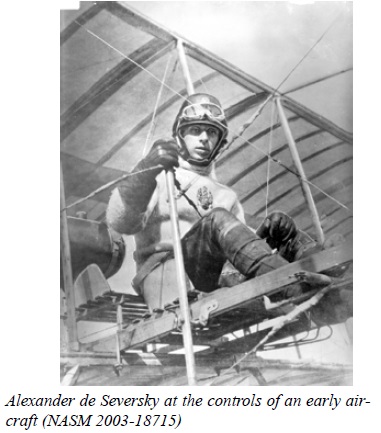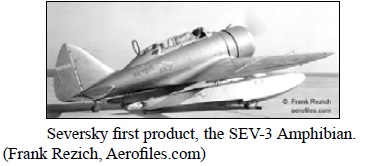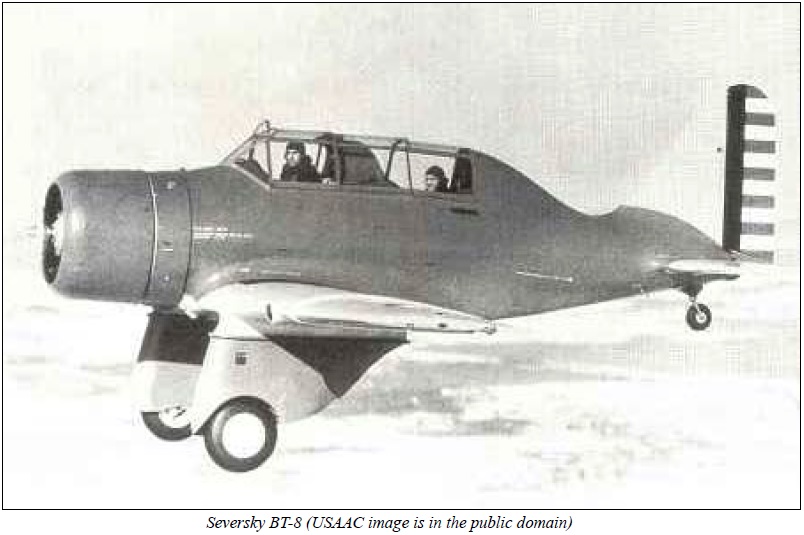by Martin Maisel
(photos as credited)
 Alexander Prokofiev de Seversky was born in 1894 to nobility in Tiflis, then part of the Russian Empire (now called Tbilisi, Georgia). His father was one of the first Russians to own an aircraft, and by the age of 14 Alexander had learned how to fly. Following the traditional path of nobility during that period, Seversky attended the Imperial Russian Naval Academy and graduated in 1914 with an engineering degree.
Alexander Prokofiev de Seversky was born in 1894 to nobility in Tiflis, then part of the Russian Empire (now called Tbilisi, Georgia). His father was one of the first Russians to own an aircraft, and by the age of 14 Alexander had learned how to fly. Following the traditional path of nobility during that period, Seversky attended the Imperial Russian Naval Academy and graduated in 1914 with an engineering degree.
When Russia joined the World War I conflict, Seversky was selected for duty as a naval aviator. After completing a postgraduate program on aeronautics, he was assigned as a pilot to an aviation unit in the Baltic fleet. On his first mission his aircraft was shot down, killing his observer and severely injuring Seversky. Doctors amputated his leg below the knee and declared him unfit for duty. However his persistent request to return to combat (while fitted with an artificial leg) gained the support of Tsar Nicholas II who intervened on his behalf, returning Seversky to an aviation fighter unit in 1916. He flew 57 missions and was credited with downing six German aircraft (his claim of 13 kills was not corroborated).
In March 1918, Seversky was assigned as an assistant naval attaché in the Russian Naval Aviation Mission in the United States. The Russian Revolution of 1917 had been making life difficult for members of the former nobility class, so Seversky elected to permanently settle in the US, instead of returning to Russia. His technical education and flying experience soon led to a number of aviation positions, including aiding General Billy Mitchell in his attempt to prove the effectiveness of air power by sinking a battleship. In the early 1920s Seversky submitted over 300 patent claims, including a gyroscopically stabilized bombsite, developed with the Sperry Gyroscope Company.
In 1923, using $50,000 from the sale of the bombsite rights to the U.S. Government, Seversky founded the Seversky Aero Corporation, focusing
on manufacturing aircraft parts and instruments. Although that company did not survive the stock market crash of 1929, Seversky re-entered the aviation industry with a new enterprise in 1931. The Seversky Aircraft Corporation, located in Long Island, New York, set out to develop an advanced, all-metal, monoplane. To accomplish that goal Seversky hired Alexander Kartveli, a skilled aeronautical engineer who was, like Seversky, from a noble family in Tbilisi, Georgia. Kartveli would serve as chief engineer.
 The first product of the Seversky Aircraft Corporation was the SEV-3. Initially configured as an amphibian, the SEV-3 set world speed records, culminating with a speed of 230 mph in 1935. This record for piston-engine amphibious aircraft remains unbroken to this day.
The first product of the Seversky Aircraft Corporation was the SEV-3. Initially configured as an amphibian, the SEV-3 set world speed records, culminating with a speed of 230 mph in 1935. This record for piston-engine amphibious aircraft remains unbroken to this day.

 In an attempt to sell the SEV-3 to the U.S. Army as a trainer, Seversky converted the amphibious aircraft to a faired, fixed landing gear arrangement. Originally powered by a 950 HP Wright-985, USAAC regulations limited trainer aircraft horsepower so the engine was replaced by a Pratt and Whitney R-985 with only 450 HP. While the U.S. Army Air Corps purchased 30 variants of the SEV-3 (designated the BT-8) in 1934, the severely underpowered trainer was soon replaced by the North American BT-9 that later evolved into the famous AT-6 trainer. However, the BT-8 has the distinction of being the first all-metal, enclosed-cockpit, lowwing monoplane to enter USAAC service.
In an attempt to sell the SEV-3 to the U.S. Army as a trainer, Seversky converted the amphibious aircraft to a faired, fixed landing gear arrangement. Originally powered by a 950 HP Wright-985, USAAC regulations limited trainer aircraft horsepower so the engine was replaced by a Pratt and Whitney R-985 with only 450 HP. While the U.S. Army Air Corps purchased 30 variants of the SEV-3 (designated the BT-8) in 1934, the severely underpowered trainer was soon replaced by the North American BT-9 that later evolved into the famous AT-6 trainer. However, the BT-8 has the distinction of being the first all-metal, enclosed-cockpit, lowwing monoplane to enter USAAC service.
In Part 2 of this brief history, the Seversky Aircraft Corporation develops its first fighter aircraft.
